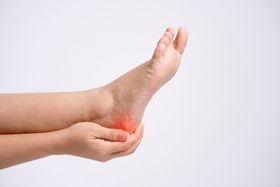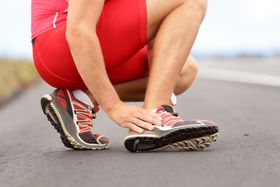Common Hiking Foot Injuries: Causes and Solutions
A board-certified physical therapist Dr. Amanda Backus shares common hiking foot injuries and how to deal with them.
Updated December 9, 2024

Your feet take a beating on the trail. One minute, you're enjoying the view; the next, you're counting every painful step.
Blisters, arch pain, and even stress fractures can stop you in your tracks. These aren't just minor annoyances—they can bench you for weeks. But here's the good news: most hiking-related foot injuries are avoidable.
Below, we bring you some practical tips on keeping your feet healthy on the trail. We'll cover the most frequent issues and show you how to prevent them.
» Start hiking confidently and prevent foot injuries with custom orthotics
Types of Common Hiking Injuries
There are two main groups of hiking injuries:
- Overuse Injuries: These injuries occur as plantar fasciitis and Achilles tendonitis. People tend to overlook them as they're expected during long hours of hiking, causing dullness that may limit walking distance or mechanics.
- Acute injuries: This group includes ankle sprains and muscle strains, often resulting from incidents like rolling your foot while on a trail. These injuries can stop your hike entirely because you may not be able to continue walking.
» Check out the best insoles for shin splints
How Do Hiking Injuries Happen?
Inadequate training and sudden increases in hiking distance or elevation can heighten the risk of injury, as your feet may not be used to such stress. Another factor can also be frequent and intense bouts of this activity without giving yourself enough time to recover.
In the event of an acute injury during hiking, it's essential to adhere to the PRICE principle to help the injured area heal effectively:
- Protection: You must stop any activity that could cause further damage. This might involve using a splint, sling, or crutches.
- Rest: Avoid putting weight or strain on the foot to allow for healing.
- Ice: Apply ice packs to the injured area to reduce swelling and pain. Wrap the area in a towel to prevent skin irritation.
- Compression: Use an elastic bandage to gently compress the foot to reduce swelling or bleeding.
- Elevation: Elevate the foot above the level of your heart whenever possible to reduce swelling.
If the pain persists even during rest after a few days, consult a physical therapist, doctor, or podiatrist. Also, take the time to heal correctly and gradually reintroduce activity to prevent long-term complications.
» Learn how to correct supination
How to Prevent Foot Injuries: Preparing for a Hike
Get Proper Footwear
When selecting footwear, it's crucial to consider the terrain and distance. For shorter, flatter hikes, you might need a more flexible pair than if you were walking up a rocky mountain.
A good hiking shoe or boot should offer ample structure and arch support without a flat interior. It should also be snug enough to prevent shifting and potential blisters but not too tight to accommodate foot swelling during longer hikes.
Additionally, waterproof options can be convenient in wet conditions because they reduce the risk of blisters and rubbing.
Note: When buying hiking shoes, always visit a physical store that has small hill models on which you can test the shoes to see how they perform.
» Explore the difference between collapsed arches and flat feet
Consider Orthotic Insoles
Using custom-made insoles during hiking to prevent injuries is quite common because hiking involves prolonged time on one's feet.
Upstep's custom-made orthotics cushion and support your foot and joints, helping prevent overuse injuries common in people with flat feet, high arches, or overpronation.
» Check out the best insoles for running with flat feet
All you need to do is order the impression kit, wait up to 4 days for it to arrive, mold your feet, and send it back to us free of charge. You can also buy them using your FSA/HSA coverage. Your funds are eligible for all of our custom orthotics, and you can combine them with any coupon on our site.
» Get your orthotics covered by insurance
Work Out
Muscle weaknesses can have long-term effects, especially if they persist over time. For example, poor hip strength causes knees to bend inward, flattening the feet and resulting in injuries along the kinetic chain (lower back, spine, etc.).
» Find the best insoles for lower back pain
To prepare for hikes and avoid common foot injuries, you should strengthen a couple of areas of your body:
- Firstly, eccentric calf raises strengthen the muscles while lengthening them, giving you the necessary support for going over inclines.
- Glute drills, such as clamshells and bird dogs, also help stabilize the hips, reducing strain on the knees and ankles.
- Walking barefoot, tiptoe walking, and heel walking are also beneficial for strengthening intrinsic foot muscles.
- You can also use resistance bands for various foot movements to build up the area around the ankle further.
- These strength-building exercises prepare the body for the demands of hiking, especially on terrain with elevation changes.
Gradually increasing hiking distance by about 10 percent per week also helps the body adapt to the added stress and build strength gradually. You'll minimize the risk of overexertion and injury.
» Explore best exercises and stretches for metatarsalgia
What to Do During a Hike
It's common for people to rely only on their toes when walking uphill. Instead, you should engage the entire foot. Doing so activates the larger glute muscles, resulting in a safe and efficient movement that will help you avoid foot injuries.
When descending, dictate your speed so you don't step on a rock or roll your ankle. Walking downhill can also put a strain on the knee joint, which can be painful for people with conditions that affect this area.
» Check out exercises for treating plantar fibroma
Note: A dynamic warm-up routine that leg swings, ankle rolls, and foot and calf stretches activates muscles and prepares them for the hike ahead.
Resting during the hike is equally essential, as fatigue can lead to decreased awareness and a higher risk of tripping or rolling an ankle. You can elevate the legs above heart level to reduce swelling.
» Explore the amazing benefits of rolling your feet
Hit the Trails Pain-Free
Your feet serve as the foundation for hiking, bearing the brunt of every step. Muscle strengthening, stability, and stretching exercises fortify them so you can be active without worrying about injuries.
Investing in proper footgear, such as boots, shoes, and personalized insoles, additionally supports your feet during risky movement.
By taking proactive steps to care for your feet before hitting the trails, you can enhance your hiking experience and pursue your outdoor adventures with greater confidence and enjoyment.
» Hike safely and prevent common foot injuries with custom orthotics
FAQs
What is the most common injury from hiking?
Blisters are the most common hiking injury. They are caused by friction between your skin and your footwear or socks.
Which muscles are affected by hiking?
Hiking is a full-body workout. Your lower body takes the brunt of the work, with quads, hamstrings, calves, glutes, and hips all participating.
Your core is crucial for stability with a backpack. Also, shoulders, arms, and chest help with balance.
What is a hiker's foot?
In the medical field, "hiker's foot" can refer to a specific skin condition associated with a muscle disease called dermatomyositis. It causes thickening and cracking of the skin on the toes and soles of the feet.
Why do hikers put vaseline on their feet?
Hikers apply Vaseline to their feet in hopes of preventing blisters, which form from friction between the skin and socks or shoes.
Why do hikers tape their feet?
Hikers tape their feet for a similar reason they might use Vaseline—to prevent blisters. The tape acts as a barrier between your skin and your socks or shoes, minimizing friction.
Can you get trench foot from hiking?
Getting trench foot from hiking is unlikely under normal circumstances. Trench foot develops from prolonged exposure to cold, wet environments where your feet stay constantly damp for days on end.
Disclaimer: The information on this blog is for educational purposes only and is not a substitute for professional medical advice.
Upstep does not provide medical diagnosis or treatment. While qualified healthcare professionals create our content, it's essential to consult with your healthcare provider for any foot or ankle concerns you may have.










